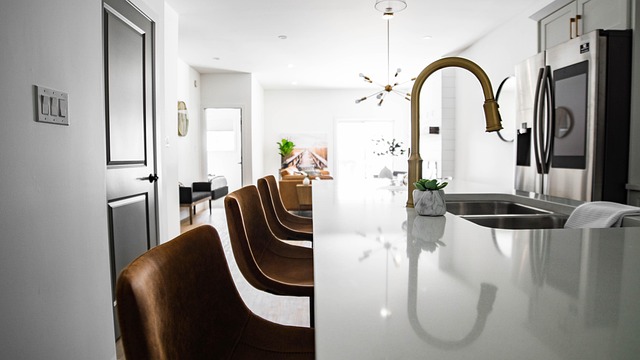Recessed kitchen lights (can lights) offer modern, energy-efficient illumination, enhancing both the functionality and aesthetics of culinary spaces. These seamless ceiling integrations focus light onto surfaces, reducing glare and eye strain. With LED bulbs, they lower carbon footprints and utility costs while providing task lighting and ambient ambiance. Selection should consider ceiling height, layout, and desired lighting effect; strategic placement, dimmers, regular cleaning, and LED replacements maximize their effectiveness for years.
Looking to illuminate your kitchen while saving energy? Reliable, energy-saving kitchen lighting starts with understanding recessed kitchen lights. This article breaks down the basics of these versatile fixtures, explores their numerous benefits, offers guidance on choosing the perfect fit for your space, and provides expert installation tips along with maintenance guidelines. Unlock a bright, efficient kitchen without compromising style with our comprehensive guide to recessed kitchen lights.
- Understanding Recessed Kitchen Lights: The Basics
- Benefits of Energy-Efficient Kitchen Lighting
- Choosing the Right Recessed Kitchen Light for Your Space
- Installation Tips and Maintenance Guidelines
Understanding Recessed Kitchen Lights: The Basics
Recessed kitchen lights, also known as can lights or pot lights, are a popular choice for modern kitchens due to their sleek and subtle design. These lighting fixtures are mounted into the ceiling, creating a clean, seamless look that enhances the overall aesthetics of the space. Beyond aesthetics, recessed lights offer practical benefits, particularly in terms of energy efficiency and functionality.
The basic setup involves a housing unit that is installed in the ceiling, typically made from materials like metal or plastic, which houses the light source—usually LED or halogen bulbs. These lights are designed to emit downward illumination, focusing the light directly onto countertops, backsplashes, or task areas like prep tables. This targeted lighting not only reduces glare but also allows for precise control of light levels, ensuring energy savings and optimal visibility when needed.
Benefits of Energy-Efficient Kitchen Lighting
Energy-efficient kitchen lighting, such as recessed kitchen lights, offers a multitude of benefits that go beyond just saving on energy bills. These modern lighting solutions are designed to enhance functionality and create a comfortable atmosphere in your culinary space. Recessed lights, for instance, can be seamlessly integrated into ceiling structures, providing uniform illumination across the entire kitchen area. This not only reduces eye strain but also allows for more practical task lighting, making preparation and cooking tasks easier and more efficient.
Additionally, energy-saving lighting technologies significantly lower carbon footprints. LED bulbs, commonly used in recessed kitchen lights, consume far less electricity than traditional incandescent bulbs. By adopting these eco-friendly options, you contribute to sustainable practices while enjoying long-term cost savings on utility expenses.
Choosing the Right Recessed Kitchen Light for Your Space
When it comes to illuminating your kitchen, selecting the appropriate recessed kitchen lights is a crucial decision that can significantly impact both functionality and aesthetics. These lights offer a sleek and integrated lighting solution, seamlessly blending with modern kitchen designs. The key to making an informed choice lies in understanding your space and its specific requirements.
Consider factors such as ceiling height, the overall layout of your kitchen, and the tasks you perform most frequently. For example, if your kitchen features low ceilings or unique architectural details, you might need recessed lights with adjustable angles to ensure optimal coverage without casting unwanted shadows. Additionally, think about the ambiance you wish to create—whether a warm, inviting glow or a bright, functional lighting scheme. The right recessed kitchen lights will enhance your space, providing both task lighting for food preparation and ambient lighting that contributes to a pleasant dining atmosphere.
Installation Tips and Maintenance Guidelines
When installing recessed kitchen lights, ensure proper placement for optimal lighting coverage. Position them strategically under cabinets or along work surfaces to create a uniform glow. Use dimmer switches to adjust light levels according to task and time of day, enhancing energy savings. Regularly clean the fixtures to maintain their brightness; dust and grease buildup can significantly impair light transmission.
For maintenance, replace bulbs as needed, opting for LED alternatives that offer longer lifespans and reduced energy consumption. Periodically inspect wiring for any signs of damage or wear, especially in high-moisture areas. Keeping these simple tips in mind will help ensure your recessed kitchen lights remain reliable and efficient, illuminating your culinary space for years to come.
Recessed kitchen lights offer a practical and aesthetically pleasing solution for illuminating your culinary space. By choosing energy-saving options, you can reduce power consumption while enjoying the benefits of bright, evenly distributed lighting. With the right selection and installation, these lights enhance your kitchen’s functionality and ambiance without breaking the bank. So, why wait? Upgrade to reliable, energy-efficient recessed kitchen lights and transform your cooking experience today.
